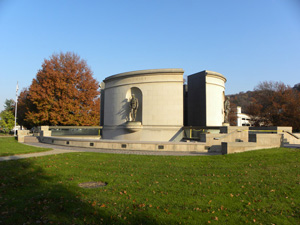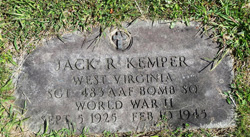

Remember...
Jack Russell Kempter
1925-1945
"There is no substitute for victory."
General Douglas MacArthur
 |
Remember...Jack Russell Kempter
|
Jack Russell Kemper was born on September 5, 1925, in Clarksburg, West Virginia, to Theodore (Teddy) and Alice Wilson Kemper. By 1936, the Kempers had divorced. Information about Ted Kemper is found in West Virginia vital records for marriages in 1936. He married Beulah Hughes in Harrison County on April 6, 1936. On this record, Ted is represented as divorced and Beulah as single.
In the 1940 Federal Census, the family was reported as living in Clarksburg with Jack Kemper and Goldie Kemper, Ted Kemper's mother.
Jack Kemper attended Washington Irving High School. A 1943 yearbook photo from the school's website ("The History of Washington Irving High School in Clarksburg," accessed 27 December 2018, http://washingtonhighschoolmemoirs.blogspot.com/search?updated-max=2014-11-05T09:19:00-08:00&max-results=7&start=1&by-date=false) shows Jack Kemper in a suit and tie for his senior photo. Descriptors in the column next to the photo include "that grin," "football," and "executive committee," and a nickname, "Pop." On the page of football players, Jack Kemper is pictured with the team, and the description next to his name says, "Pop . . . fullback . . . always the blocker, never the runner . . . senior . . . 160 pounds of dynamite . . . height 6'."
It appears that Jack Kemper enrolled in West Virginia University and intended to play football for the Mountaineers. The Raleigh Register of Beckley, West Virginia, carried in its September 5, 1943, issue an article titled "West Virginia Squad Needs Plenty of Work Before Grid Season Opens." The location line indicates Morgantown, and the article describes the first week of the pre-season. Jack Kemper is mentioned near the end of the article as an impressive newcomer in the backfield from Washington Irving.
On January 14, 1944, Jack Kemper listed his residence in Washington, Pennsylvania. He was perhaps living with his mother or her relatives, since this is where she was from. Jack Kemper enlisted in the U.S. Army during World War II at Fort George G. Meade in Maryland. He served with the 505th Bombardment Group, 483rd Bomb Squad of the Army Air Force. A relative of one of the crew, which included Jack Kemper, has gathered extensive information about the plane, the crew, and the missions of U.S. troops in the Tinian Islands and posted it on the website "The B-29 Superfortress 'Jook' Girl (42-65255) February 10, 1945." A letter he wrote home in June 1944 is posted on this site. In it, Jack Kemper describes his disappointment of not getting furlough that all had expected to have before shipping out, a trip to the dentist, the new bomber, his misgivings about shipping out, and the ship he'd sail in. He concludes with the big news that he and his girlfriend hoped to wed when the war was over.
The Tinian Islands were a Japanese stronghold and had been since World War I. By World War II, it was especially important for Japan to hold the Tinian Islands because the airplanes of World War II were of such capacity that they could reach Japan from air bases located on the islands. Japan lost the Tinian Islands in August 1944 after a two-month assault that resulted in the deaths of 300 American servicemen, but 6000 Japanese. After that, the United States began building large air bases, one of which would be the largest in the world by the end of 1945.
Bombing raids launched from Tinian were dangerous. The route to the Philippines and Japan was 1500-1700 miles long, and it was all over water. Because the round trip was over 3000 miles long and took 12 hours to complete, the planes were overloaded with fuel. This seems to have caused many crashes on or shortly after take-off. It would be later in 1945 that the planes delivering nuclear payloads to Japan would launch from Tinian to Nagasaki and Hiroshima. Aside from the continuous bombing raids directly on the Philippines and Japan, the military operations based in the islands also disrupted food supplies to Japan. The importance of the Tinian operations to the United States was key to the outcome of World War II. (Summary based on "The Use of Tinian Island During World War II," accessed 19 October 2018, https://web.mst.edu/~rogersda/umrcourses/ge342/Tinian%20Island.pdf) and "Tinian Island," Atomic Heritage Foundation, accessed 19 October 2018, https://www.atomicheritage.org/location/tinian-island.)
By January 1945, the 505th had reached North Field, an airport on Tinian. The 505th underwent a training program to get them flight and combat ready and was judged to be ready to fly by February 1945. According to 505th Bombardment Group history website,
On 4 February 1945 the group took part in the first multi-wing attack on the Japanese Home Islands, taking part in a 129-aircraft attack on Kobe. Only 69 aircraft from the 129 reached their target, but the raid was judged to have been effective. February also saw attacks on Iwo Jima and Truk. The group received a Distinguished Unit Citation very early in its combat career, for a raid on the Nakajima factory at Ota in February 1945. ("History," accessed 19 October 2018, http://www.historyofwar.org/air/units/USAAF/505th_Bombardment_Group.html.)
The Jook Girl plane and crew had a successful mission during the February 4 raid. The next mission for Jook Girl was February 10, 1945, with a new crew. Jack Kemper belonged to a crew of 11 that flew the B-29 Superfortress. Jack Kemper flew in the right gun blister. Twenty-one planes were scheduled to fly the mission to Ota, Japan. Eighteen of the planes were able to become airborne, two aborted from take-off, and one, the Jook Girl, crashed on take-off. (Information compiled from "The B-29 Superfortress 'Jook' Girl [42-65255] February 10, 1945," accessed 19 October 2018, https://jookgirl.weebly.com/ and "The 505th Bombardment Group, 1944-1945: A Report from the 484th Bomb Squadron," accessed 19 October 2018, http://b-29.org/313BW/505thbg/MacIntyre-history1.pdf.) From page 13 of the report:
On the tenth of February, twentyone of our Groups B-29s taxied down the North Field runways for the second major mission to Japan. The target this time was the Nakajima Aircraft Factory at Ota, Japan. Two Superforts aborted before takeoff; one bomber failed to gain lift on the long runway and crashed into a large mound at the east end of the air- strip. All eleven crew members were instantly killed in the explosion of bombs and gasoline. The aircraft itself was completely demolished, parts being scattered over a wide area.
However, in materials collected for the Jook Girl website, a letter is published that provides further detail of the crash. According to the contents of the letter, which relays an eyewitness account, all the bodies of the crew members were recovered and identifiable. This is because the tragic crash unfolded in stages. The plane failed to gain enough altitude to fly but was going too fast for the crew to stop. The eyewitness supposed that the crew could have turned left or right near the end of the runway and perhaps saved the plane and their lives, but so many people were gathered that the maneuver would have meant taking the lives of those who were along the runway. The plane went over the end of the runway and hit the mound of dirt. Though by-standers had to have known that the plane, fully loaded with fuel and bombs, would explode, they ran into the plane to look for survivors, but there were none. They pulled the bodies out before the inevitable explosions occurred. (Letter written on November 15, 1945, from Pauline, believed to be Pauline Sokell, sister of one of the crew, to Mrs. Quay, mother of one of the crew. The account was a summary of information given to Pauline Sokell by an eyewitness, Lt. Robert Suchy.)
The Jook Girl site carries photos of Jack Kemper and the Jook Girl crew and memorial items provided by Jack Kemper's family. These include the March 1945 telegram that carried the news to Jack Kemper's family; a sympathy card from General George C. Marshall; and a description of the Purple Heart, his Purple Heart citation, and the letter referenced above.
| Jack Kemper is buried in Greenlawn Cemetery in Harrison County, West Virginia. |  Headstone for Sgt. Jack R. Kemper, Greenlawn Cemetery. Courtesy Cynthia Mullens |
Article prepared by by Cynthia Mullens
November 2018

West Virginia Archives and History welcomes any additional information that can be provided about these veterans, including photographs, family names, letters and other relevant personal history.